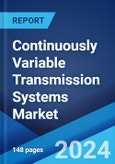A continuously variable transmission (CVT) system refers to an automatic transmission system that changes through an uninterrupted range of different gear ratios. It has a two-pulley mechanism with variable diameters connected on either end of the engine and the wheels by a belt or chain. Also known as stepless transmission, pulley transmission and single-speed transmission, the CVT system effectively replaces gears with two variable-diameter pulleys. As a result, it offers useable power and driving convenience as compared to automatic transmission systems. Moreover, the CVT system is extremely fuel-efficient and provides maximum speed at low engine speed. They are also light-weighted, compact-sized, and consist of fewer moving parts, making them suitable for diverse automotive applications.
Continuously Variable Transmission Systems Market Trends
The global CVT system market is driven by various advantages, such as a smooth driving experience and quick acceleration for users. It also offers more useable power and consumes less fuel than conventional and manual transmission systems. As a result, the CVT system finds applications in tractors, snowmobiles, motor scooters, go-carts, and mix harvesters. Nowadays, consumers are shifting toward eco-friendly vehicles, which utilize CVT systems. It also consists of enhanced hydraulic systems, microprocessors, high-strength steel metal belts, and high-speed sensors, which help boost the handling capacity of the engine. Furthermore, several manufacturers, like Toyota, are producing hybrid, electric mid-sized hatchback models, which are equipped with power-split CVT technology. It offers a fixed gear ratio and higher torque handling capability, which are expected to escalate the demand for CVT systems.Market Segmentation
This report provides an analysis of the key trends in each sub-segment of the global continuously variable transmission systems market report, along with forecasts at the global and regional level from 2025-2033. The report has categorized the market based on type, vehicle type, fuel, capacity, and end user.Breakup by Vehicle Type
- Passenger cars
- Light commercial vehicles
- Heavy commercial vehicles
- Others
Breakup by Type
- Hydrostatic
- Toroidal
- Cone
- Variable geometry
- Variable diameter
- Others
Breakup by Fuel
- Gasoline
- Diesel
- Hybrid
Breakup by Capacity
- Up to 1.5 L
- 1.5 L to 3.0 L
- Above 3.0 L
Breakup by End User
- OEM
- Aftermarket
Regional Insights
- Asia Pacific
- North America
- Europe
- Middle East and Africa
- Latin America
Competitive Landscape
The competitive landscape of the market has been analyzed, with some of the leading players being TEAM Industries Inc., Schaeffler AG, Endurance Technologies Limited, NIDEC-SHIMPO, ZF Friedrichshafen AG, STEYR, Toyota Motor Corporation, Gaokin Industry Co. Ltd., General Transmissions, and Fallbrook Intellectual Property Company LLC.Key Questions Answered in This Report
1. What was the size of the global continuously variable transmission systems market in 2024?2. What is the expected growth rate of the global continuously variable transmission systems market during 2025-2033?
3. What are the key factors driving the global continuously variable transmission systems market?
4. What has been the impact of COVID-19 on the global continuously variable transmission systems market?
5. What is the breakup of the global continuously variable transmission systems market based on the vehicle type?
6. What is the breakup of the global continuously variable transmission systems market based on the type?
7. What is the breakup of the global continuously variable transmission systems market based on the fuel?
8. What is the breakup of the global continuously variable transmission systems market based on the capacity?
9. What is the breakup of the global continuously variable transmission systems market based on the end user?
10. What are the key regions in the global continuously variable transmission systems market?
11. Who are the key players/companies in the global continuously variable transmission systems market?
Table of Contents
Companies Mentioned
- TEAM Industries Inc.
- Schaeffler AG
- Endurance Technologies Limited
- NIDEC-SHIMPO
- ZF Friedrichshafen AG
- STEYR
- Toyota Motor Corporation
- Gaokin Industry Co. Ltd.
- General Transmissions
- Fallbrook Intellectual Property Company LLC
Table Information
| Report Attribute | Details |
|---|---|
| No. of Pages | 140 |
| Published | February 2025 |
| Forecast Period | 2024 - 2033 |
| Estimated Market Value ( USD | $ 23.2 Billion |
| Forecasted Market Value ( USD | $ 35.8 Billion |
| Compound Annual Growth Rate | 4.9% |
| Regions Covered | Global |
| No. of Companies Mentioned | 10 |









